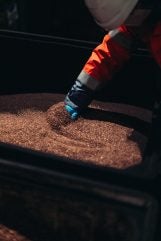
Veolia UK has introduced a process to recover copper from electrical cables in nuclear facilities, which were previously treated using high-temperature incineration. The process represents a significant carbon saving as recycling the copper saves around 85% of the emissions associated with original ore extraction.
The process, part of Veolia’s strategic GreenUP programme can effectively manage the hazardous waste from decommissioned nuclear facilities and recover valuable resources. By developing a new method of safe handling to dispose of the contaminated plastic coating that protects the core from radiation, the new process reduces the treatment time and cost, and preserves the valuable copper for recycling.
Estimates show that standard thin gauge to heavy duty electrical cables will constitute hundreds of tonnes of waste during planned decommissioning across various projects. In an initial trial, Veolia processed over 12 tonnes of cables that were safely handled and stripped of the contaminated plastic coating, cut and packaged into drums for safe treatment using high temperature incineration. The resultant exposed cores were tested for radioactivity and found to be safe, producing four tonnes of copper for recycling.
Copper is used in a vast range of applications such as electrical equipment such as computers, TVs and mobile phones, household white goods, motors, generators, vehicles, power generation, construction, plumbing, cookware, coins, musical instruments and even sculptures. Despite being a common metallic element with trillions of tonnes in the earth’s crust, only a tiny fraction is economically viable to recover with present-day prices and technologies. Estimates of copper reserves available for mining vary from 25 to 60 years.
With global operations spanning across various projects including the Magnox decommissioning programme, Veolia provides turnkey solutions from initial surveys and characterisation through decontamination, dismantling and segregation, to packaging and appropriate disposal using a methodology that ensures decommissioning projects are executed safely. These operations use a range of technologies and services for facility restoration, decommissioning of plants, and the company has pioneered many best practices for the safe demolition of complex structures within live facilities, and was the first demolition company to use explosive techniques for the demolition of a facility on a UK nuclear licensed site.
Nicola Henshaw, managing director of hazardous waste at Veolia UK said the new process has helped the nuclear industry to significantly reduce its waste and salvage valuable materials. “As more end-of-life nuclear facilities are decommissioned this new process represents a new way of capturing valuable resources from this industry,” she noted. “With pressure on the earth’s copper reserves, more demand from industry, and the need to reduce carbon emissions, this latest innovation marks an advance towards a circular economy.”
The Veolia group operates in 57 countries employing more than 210,000 people across waste management, water management and energy services. In the UK, its operations include the decommissioning programme for Magnox nuclear reactors where its work ranges from initial surveys through decontamination to appropriate disposal.






